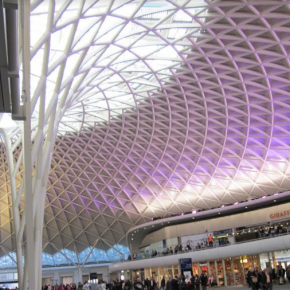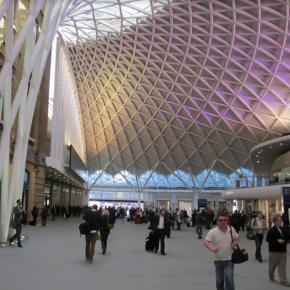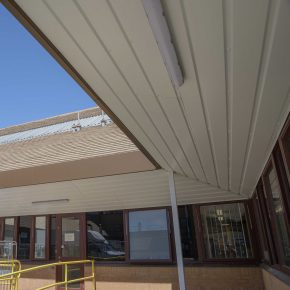
How the King’s Cross disaster changed fire safety regulations
Thirty years on from the King’s Cross disaster, Wrightstyle’s managing director, Tim Kemppster, remembers the tragedy and the redevelopment of the station.
The King’s Cross fire that claimed the lives of 31 people lead to better fire safety regulation and helped companies like Wrightstyle gain a better understanding of an unknown dynamic in how a small fire can become a conflagration.
Started most probably by a discarded match, despite smoking having been banned in the Underground two years earlier, the source of the fire was a partially wooden escalator shaft. In addition, the running track of the escalator had not been cleaned since the 1940s and was covered in grease and filled with rubbish.
With a lack of visible flames, the firemen first on the scene believed that it posed little threat, however, the fire rapidly grew, appearing to flash over and fill the ticket hall with flames and smoke. It was later revealed that a combination of wind movements caused by underground trains arriving and leaving created a 12mph wind, pushing air from the tunnels upwards and adding to the speed of the fire spreading.
 Brand new computer modelling and fire stimulation promoted a new theory of fire development within inclined shafts.The theory is called the trench effect, and involved hot gases in the buoyant plume to lie along the escalator surface, creating a rapid airflow that caused the gases to move up the escalator, increasing in proportion to the size of the fire, and eventually creating an effect much like a flamethrower, sending flames shooting upwards into the ticket hall.
Brand new computer modelling and fire stimulation promoted a new theory of fire development within inclined shafts.The theory is called the trench effect, and involved hot gases in the buoyant plume to lie along the escalator surface, creating a rapid airflow that caused the gases to move up the escalator, increasing in proportion to the size of the fire, and eventually creating an effect much like a flamethrower, sending flames shooting upwards into the ticket hall.
The computer modelling of the “fluid flow” of the fire helped to substantially advance the science of fire dynamics, using computational stimulation to look at how fires behave, with an emphasis on smoke and heat movement from their source.
Consequently, all wooden escalators were replaced, automatic sprinklers were installed and heat detectors in escalators, and all station staff are now required to take part in fire safety training twice a year.
Computer modelling has helped inform fire training since and influenced how Wrightstyle mitigates against threats caused by fire.
In supplying glazed components to the frontage of the new King’s Cross, as well as a safe evacuation route from the main administrative areas, we have brought a wealth of experience and expertise from other UK transport infrastructure projects, as well as overseas contract in Hong Kong and Dubai. Our advice to specifiers, based on extensive fire and bomb testing, is simple: always specify the glass and steel components as one integrated and tested assembly.
King’s Cross has had to learn painful lessons from its past, to build a facility offering the safety possible transit for its millions of customers every year. The lessons learned have also been applied in cities across the world.
Wrightstyle,
Unit 2&7 Banda Trading Estate,
Nursteed Road,
Devizes,
United Kingdom,
SN10 3DY
Visit Supplier's page
Latest news

26th April 2024
Alumasc Skyline and Rainwater package specified at Weston-super-Mare Hospital
A package of products from Alumasc Water Management Solutions (AWMS) has been used for the external refurbishment of the roofline at Weston General Hospital in Weston-Super-Mare.
Posted in Aluminium Products, Articles, Building Industry News, Building Products & Structures, Building Services, Building Systems, Case Studies, Cladding, Drainage Services, Drainage, Guttering, Soffits & Fascias, Fascias, Restoration & Refurbishment, Retrofit & Renovation, Roofs, Walls
26th April 2024
Hush Acoustics optimises fleet operations by securing FORS Gold accreditation
Hush Acoustics has invested in the safety and sustainability of its commercial vehicle fleet by achieving Gold status in the Fleet Operator Recognition Scheme (FORS).
Posted in Acoustics, Noise & Vibration Control, Articles, Building Industry News, Building Products & Structures, Building Regulations & Accreditations, Building Services, Ceilings, Facility Management & Building Services, Floors, Health & Safety, Insulation, Restoration & Refurbishment, Retrofit & Renovation, Site Preparation, Sustainability & Energy Efficiency, Walls, Waste Management & Recycling
26th April 2024
Safeguard Europe: Penetrating damp - how to diagnose the damage
As Safeguard gets ready to deliver another informative session of one of its most popular webinars, the company outlines some of the most common reasons for rain penetration through brickwork.
Posted in Articles, Bricks & Blocks, Building Industry Events, Building Industry News, Building Products & Structures, Building Services, Continuing Professional Development (CPD's), Damp & Waterproofing, Facility Management & Building Services, Information Technology, Posts, Render, Restoration & Refurbishment, Retrofit & Renovation, Seminars, Training, Walls
25th April 2024
ADSA: Competence Initiative Makes Progress
The Joint Competency Initiative (JCI), in which the Automatic Door Suppliers Association (ADSA) is involved, is finalising its first framework for installers within the door, gates and shutter industry.
Posted in Access Control & Door Entry Systems, Architectural Ironmongery, Articles, Building Associations & Institutes, Building Industry Events, Building Industry News, Building Products & Structures, Building Regulations & Accreditations, Building Services, Continuing Professional Development (CPD's), Doors, Facility Management & Building Services, Health & Safety, Innovations & New Products, Publications, Research & Materials Testing, Restoration & Refurbishment, Retrofit & Renovation, Security and Fire Protection, Site Preparation
 Sign up:
Sign up: